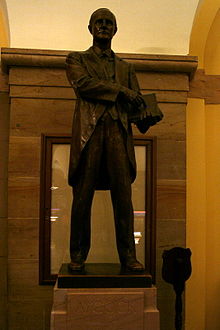- Charles Brantley Aycock
-
Charles Brantley Aycock (November 1, 1859 – April 4, 1912) was the 50th Governor of the U.S. state of North Carolina from 1901 to 1905. During his tenure as governor, he was an advocate for the improvement of the state's public school systems, and following his term in office, he traveled the country promoting educational causes.
For most of the 20th century, Aycock was treated by historians and North Carolina politicians as an admirable, almost saintly figure. In recent years, that viewpoint is under review, according to a major North Carolina newspaper.[1]
Often overlooked was Aycock's role as a leading spokesman in the white supremacy campaigns of 1898 and 1900, which historians say were marked by widespread violence, voter intimidation, voter fraud and even a coup d'état of the government of Wilmington. ... The campaigns had far-reaching consequences: Blacks were removed from the voter rolls based on literacy tests, Jim Crow customs were encoded into law, and the Democratic Party controlled Tar Heel politics for two-thirds of the 20th century.[2]
Contents
Early life
Charles B. Aycock was born in Wayne County, North Carolina as the youngest of the 10 children of Benjamin and Serena Aycock. His family lived near the present-day town of Fremont, North Carolina, then known as Nahunta. Though his father died when he was 15, his mother and older brothers recognized his abilities and determined that he should go to college. Aycock attended the University of North Carolina at Chapel Hill and joined Philanthropic Society, a debate and literary society at the university. After graduating in 1880 with first honors in both oratory and essay writing, he entered law practice in Goldsboro and supplemented his income by teaching school. His success in both fields led to his appointment as superintendent of schools for Wayne County and to service on the school board in Goldsboro.
His political career began in 1888 as a presidential elector for Grover Cleveland, when he gained distinction as an orator and political debater. From 1893 to 1897 he served as U.S. attorney for the Eastern District of North Carolina. In 1898 and 1900, Aycock was prominent in the Democratic Party's "white supremacy" campaigns and was elected Governor over Republican Spencer Adams.[3]
Governor
As governor, Aycock became known as the "Education Governor" for his support of the public school system. It was said that one school was constructed in the state for every day he was in office. He was supposedly dedicated to education after watching his mother make her mark when signing a deed. He felt that no lasting social reform could be accomplished without education. He supported increased salaries for teachers, longer school terms, and new school buildings; "690 new schoolhouses erected, including 599 for whites and 91 for blacks."[4]
According to John Beck, Wendy Frandsen, and Aaron Randall of Vance-Granville Community College, "Charles B. Aycock--the same Charles B. Aycock who helped lead the White Supremacy Campaign--is generally considered the state's first progressive governor. Despite Aycock's unsavory role as a white supremacist, he is still remembered and honored in the state today as the father of public education, and there are few counties in the state where one cannot find a public school named after him."[5]
Later Years and Legacy
After leaving the governor's office in 1905, Aycock resumed his law practice. He was persuaded to run for the Senate seat held by fellow Democrat Furnifold M. Simmons in 1912. But before the nomination was decided, Aycock died of a heart attack while making a speech to the Alabama Education Association in Birmingham on April 4, 1912.
"The subject of Aycock's speech was 'Universal Education'. After he had talked for a few minutes, amidst enthusiastic applause, Aycock spoke the words: 'I have always talked about education -.' Here he stopped, threw up his hands, reeled backward, and fell dead." [6]
In Greensboro, North Carolina, the auditorium at UNC Greensboro, as well as a street, a neighborhood, and a middle school are all named for him.[7] There are dormitories at UNC-Chapel Hill, East Carolina University and Duke University campuses named after him. In Pikeville, North Carolina, there is a high school named after him as well.
A bronze statue of Aycock by Charles Keck was submitted by the North Carolina Legislature to the National Statuary Hall Collection in 1932. The statue is located in the crypt of the capitol building along with other statues from the original 13 colonies.
References
- ^ http://www.newsobserver.com/news/story/728032.html RaleighNews&ObserverAycock legacy gets reappraisal
- ^ http://www.newsobserver.com/news/story/728032.html RaleighNews&ObserverAycock legacy gets reappraisal
- ^ Our Campaigns - NC Governor Race - Aug 02, 1900
- ^ Aycock legacy gets reappraisal News and Observer Rob Christensen, Staff Writer Published: Oct 06, 2007
- ^ [1]
- ^ The Federal Writers' Project of the Federal Works Agency, Works Projects Administration for the State of North Carolina, "North Carolina: A Guide to the Old North State", The University of North Carolina Press, Chapel Hill, 1939, page 79.
- ^ "The risk of choosing names" : News-Record.com : Greensboro, North Carolina
External links
- Charles B. Aycock Birthplace Historic Site
- North Carolina Election of 1898
- Aycock legacy gets reappraisal
- 1905 Magazine Article by Aycock
Political offices Preceded by
Daniel Lindsay RussellGovernor of North Carolina
1901–1905Succeeded by
Robert Broadnax GlennCategories:- 1859 births
- 1912 deaths
- American white nationalists
- Duke University people
- Governors of North Carolina
- History of racism in the United States
- Political violence in the United States
- Racial segregation
- Burials in Historic Oakwood Cemetery
- United States Attorneys for the Eastern District of North Carolina
- White supremacy in the United States
Wikimedia Foundation. 2010.




